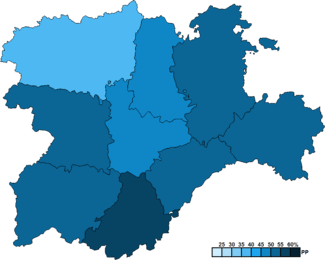2003 Castilian-Leonese regional election
The 2003 Castilian-Leonese regional election was held on Sunday, 25 May 2003, to elect the 6th Cortes of the autonomous community of Castile and León. All 82 seats in the Cortes were up for election. The election was held simultaneously with regional elections in twelve other autonomous communities and local elections all throughout Spain.
| |||||||||||||||||||||||||||||||||||||||||||||
All 82 seats in the Cortes of Castile and León 42 seats needed for a majority | |||||||||||||||||||||||||||||||||||||||||||||
|---|---|---|---|---|---|---|---|---|---|---|---|---|---|---|---|---|---|---|---|---|---|---|---|---|---|---|---|---|---|---|---|---|---|---|---|---|---|---|---|---|---|---|---|---|---|
| Registered | 2,177,222 | ||||||||||||||||||||||||||||||||||||||||||||
| Turnout | 1,581,983 (72.7%) | ||||||||||||||||||||||||||||||||||||||||||||
| |||||||||||||||||||||||||||||||||||||||||||||
 Constituency results map for the Cortes of Castile and León | |||||||||||||||||||||||||||||||||||||||||||||
| |||||||||||||||||||||||||||||||||||||||||||||
Overview
Electoral system
The Cortes of Castile and León were the devolved, unicameral legislature of the autonomous community of Castile and León, having legislative power in regional matters as defined by the Spanish Constitution and the Castilian-Leonese Statute of Autonomy, as well as the ability to vote confidence in or withdraw it from a President of the Junta.[1] Voting for the Cortes was on the basis of universal suffrage, which comprised all nationals over eighteen, registered in Castile and León and in full enjoyment of their political rights.
All members of the Cortes of Castile and León were elected using the D'Hondt method and a closed list proportional representation, with a threshold of 3 percent of valid votes—which included blank ballots—being applied in each constituency. Parties not reaching the threshold were not taken into consideration for seat distribution. Additionally, the use of the D'Hondt method might result in an effective threshold over three percent, depending on the district magnitude.[2] Seats were allocated to constituencies, corresponding to the provinces of Ávila, Burgos, León, Palencia, Salamanca, Segovia, Soria, Valladolid and Zamora. Each constituency was entitled to an initial minimum of three seats, being allocated one additional member per each 45,000 inhabitants or fraction greater than 22,500.[1][3]
The electoral law provided that parties, federations, coalitions and groupings of electors were allowed to present lists of candidates. However, groupings of electors were required to secure the signature of at least 1 percent of the electors registered in the constituency for which they sought election. Electors were barred from signing for more than one list of candidates. Concurrently, parties and federations intending to enter in coalition to take part jointly at an election were required to inform the relevant Electoral Commission within ten days of the election being called.[3][4][5]
Election date
The term of the Cortes of Castile and León expired four years after the date of their previous election. Elections to the Cortes were fixed for the fourth Sunday of May every four years. The previous election was held on 13 June 1999, setting the election date for the Cortes on Sunday, 25 May 2003.[1][3][4][5]
The President of the Junta had the prerogative to dissolve the Cortes of Castile and León and call a snap election, provided that no motion of no confidence was in process, no nationwide election was due and some time requirements were met: namely, that dissolution did not occur either during the first legislative session or within the legislature's last year ahead of its scheduled expiry, nor before one year had elapsed since a previous dissolution. In the event of an investiture process failing to elect a regional President within a two-month period from the first ballot, the Cortes were to be automatically dissolved and a fresh election called. Any snap election held as a result of these circumstances would not alter the period to the next ordinary election, with elected procurators merely serving out what remained of their four-year terms.[1][6]
Results
Overall
 | ||||||
| Parties and coalitions | Popular vote | Seats | ||||
|---|---|---|---|---|---|---|
| Votes | % | ±pp | Total | +/− | ||
| People's Party (PP) | 760,510 | 48.49 | –1.96 | 48 | ±0 | |
| Spanish Socialist Workers' Party (PSOE) | 576,769 | 36.77 | +3.71 | 32 | +2 | |
| Leonese People's Union (UPL) | 60,331 | 3.85 | +0.15 | 2 | –1 | |
| United Left of Castile and León (IUCyL) | 54,085 | 3.45 | –1.98 | 0 | –1 | |
| Commoners' Land–Castilian Nationalist Party (TC–PNC) | 18,595 | 1.19 | –0.20 | 0 | –1 | |
| Independent Candidacy–The Party of Castile and León (CI–PCL) | 11,180 | 0.71 | +0.25 | 0 | ±0 | |
| The Greens (LV) | 7,424 | 0.47 | +0.42 | 0 | ±0 | |
| The Greens–Cives (LV–Cives) | 1,459 | 0.09 | New | 0 | ±0 | |
| Union of the Salamancan People (UPSa) | 6,630 | 0.42 | New | 0 | ±0 | |
| Regionalist Unity of Castile and León (URCL) | 5,323 | 0.34 | –0.43 | 0 | ±0 | |
| Castilian Left (IzCa) | 3,972 | 0.25 | New | 0 | ±0 | |
| Democratic and Social Centre (CDS) | 3,016 | 0.19 | –0.52 | 0 | ±0 | |
| United Zamora (ZU) | 2,579 | 0.16 | New | 0 | ±0 | |
| Republican Left (IR) | 2,420 | 0.15 | New | 0 | ±0 | |
| Party of El Bierzo (PB) | 2,286 | 0.15 | –0.11 | 0 | ±0 | |
| The Greens–Green Group (LV–GV) | 2,196 | 0.14 | +0.05 | 0 | ±0 | |
| Leonese United Independent Citizens (CiuLe) | 2,051 | 0.15 | New | 0 | ±0 | |
| Humanist Party (PH) | 2,038 | 0.13 | –0.03 | 0 | ±0 | |
| Zamoran People's Union (UPZ) | 1,998 | 0.13 | +0.02 | 0 | ±0 | |
| Initiative for the Development of Soria (IDES) | 1,908 | 0.12 | New | 0 | ±0 | |
| Salamanca–Zamora–León–PREPAL (PREPAL) | 1,620 | 0.10 | –0.11 | 0 | ±0 | |
| Independent Segovian Alternative (ASí) | 1,314 | 0.08 | New | 0 | ±0 | |
| The Phalanx (FE) | 1,197 | 0.08 | New | 0 | ±0 | |
| Regionalist Party of El Bierzo (PRB) | 1,041 | 0.07 | New | 0 | ±0 | |
| Liberal Centrist Union (UCL) | 652 | 0.04 | New | 0 | ±0 | |
| Independent Spanish Phalanx–Phalanx 2000 (FEI–FE 2000) | 556 | 0.04 | New | 0 | ±0 | |
| Spanish Democratic Party (PADE) | 465 | 0.03 | –0.19 | 0 | ±0 | |
| Authentic Phalanx (FA) | 243 | 0.02 | New | 0 | ±0 | |
| Blank ballots | 36,027 | 2.30 | –0.37 | |||
| Total | 1,568,426 | 82 | –1 | |||
| Valid votes | 1,568,426 | 99.14 | +0.09 | |||
| Invalid votes | 13,557 | 0.86 | –0.09 | |||
| Votes cast / turnout | 1,581,983 | 72.66 | +5.08 | |||
| Abstentions | 595,239 | 27.34 | –5.08 | |||
| Registered voters | 2,177,222 | |||||
| Sources[7][8][9] | ||||||
Distribution by constituency
| Constituency | PP | PSOE | UPL | |||
|---|---|---|---|---|---|---|
| % | S | % | S | % | S | |
| Ávila | 59.4 | 5 | 32.1 | 2 | ||
| Burgos | 53.2 | 7 | 33.6 | 4 | ||
| León | 38.9 | 6 | 36.0 | 6 | 17.8 | 2 |
| Palencia | 48.6 | 4 | 41.6 | 3 | ||
| Salamanca | 51.7 | 7 | 36.8 | 4 | ||
| Segovia | 50.8 | 4 | 36.4 | 2 | ||
| Soria | 53.4 | 3 | 36.6 | 2 | ||
| Valladolid | 46.3 | 8 | 39.9 | 6 | ||
| Zamora | 50.8 | 4 | 36.5 | 3 | 3.0 | − |
| Total | 48.5 | 48 | 36.8 | 32 | 3.8 | 2 |
| Sources[7][8][9] | ||||||
Aftermath
| Investiture Juan Vicente Herrera (PP) | ||
| Ballot → | 2 July 2003 | |
|---|---|---|
| Required majority → | 42 out of 82 | |
Yes
|
48 / 82 | |
34 / 82 | ||
| Abstentions | 0 / 82 | |
| Absentees | 0 / 82 | |
| Sources[9] | ||
References
- "Statute of Autonomy of Castile and León of 1983". Organic Law No. 4 of 25 February 1983. Official State Gazette (in Spanish). Retrieved 16 September 2017.
- Gallagher, Michael (30 July 2012). "Effective threshold in electoral systems". Trinity College, Dublin. Archived from the original on 30 July 2017. Retrieved 22 July 2017.
- "Castile and León Electoral Law of 1987". Law No. 3 of 30 March 1987. Official Gazette of Castile and León (in Spanish). Retrieved 15 September 2017.
- "General Electoral System Organic Law of 1985". Organic Law No. 5 of 19 June 1985. Official State Gazette (in Spanish). Retrieved 28 December 2016.
- "Representation of the people Institutional Act". www.juntaelectoralcentral.es. Central Electoral Commission. Retrieved 16 June 2017.
- "Statute of Autonomy of Castile and León Reform of 1999". Organic Law No. 4 of 8 January 1999. Official State Gazette (in Spanish). Retrieved 16 September 2017.
- "Elections to the Cortes of Castile and León". servicios.jcyl.es (in Spanish). Junta of Castile and León. Retrieved 14 January 2018.
- "Cortes of Castile and León election results, 25 May 2003" (PDF). www.juntaelectoralcentral.es (in Spanish). Electoral Commission of Castile and León. 9 July 2003. Retrieved 24 September 2017.
- "Cortes of Castile and León elections since 1983". historiaelectoral.com (in Spanish). Electoral History. Retrieved 24 September 2017.
.jpg)
